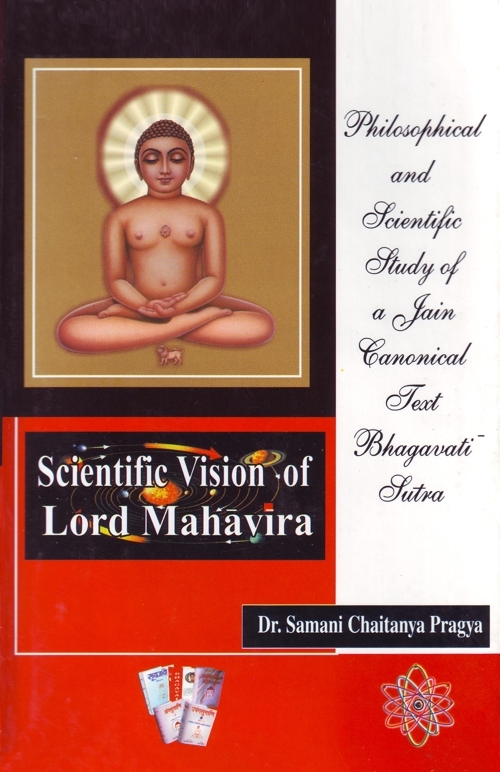Space is the substance which is accepted almost by all the Indian and Western thinkers. The noteworthy thing in this connection is that such comprehensive and critical discussion about space, as found in Jain metaphysics, is not traceable in other philosophical systems like Buddhist, Vaisheshika, Samkhya and Vedānta schools. In the Buddhist philosophy, space is regarded as having the characteristic of āvaraṇābhāva (absence of pervasion)[33] and it is considered to be simple element (asaṁskṛta dharma).[34] On the contrary, in the Jain philosophy, it is not postulated in a negative connotation, in terms of non-existence (abhāva). Further, it is not regarded as asaṁskṛta dharma, since it really exists[35] and has the general and special characteristics, such as, origination, permanence and destruction along with accommodation etc.[36] According to the definition of the substance also, space is a substance because it is never devoid of qualities and modes, their association being natural and eternal substances are distinguished from one another. Here, the specific quality i.e. accommodation or receptacle of space distinguishes it from other objects. This is the reason the Bh.S dealing with five extended realities, it describes space as a separate independent real.
According to Nayacakra Vṛtti, space is of sixteen types of general and specific nature.[37]
Vaiseshikas have propounded the concept of space as independent substance and it has quality of producing sound (śabda).[38] They have considered the direction (dik) as different from space.[39] Accordingly, that which has the attribute of sound is space, and that which limits the external world by direction is dik.[40] Nyaya-kārikāvalī defines direction which has the attributes of the farness and nearness (dūrtva and sāmipya) and which makes distinction between one place and the other. Direction is one and eternal (nitya). By purpose or empirical consideration it is called the East and the West and other directions. But according to the Bh.S[41] direction is not distinct from the space. In fact, the directions are specific determinations of space and do not constitute a different substance.[42]
According to the text, direction is a measurement of cosmic-space with reference to the various locations. All the directions begin[43] from the central part of the mount Meru situated in the center of middle part of the universe.
The canonical texts refer two types of word, viz; direction (diśā) and intermediate direction (anudiśā).[44] East, West, North and South these are directions. These begin with two space-points and increasing by two it covers infinite number of space-points in the end. Intermediate direction is a part of direction. The intermediate direction like upward direction (ūrdhva diśā) and downward direction (adho diśā) begins with four space-points and remains same till the end. There is no increase in the space-points of intermediate one.
There are found different descriptions regarding direction in Jain canonical texts. Generally the East is the direction in which the sun rises. The direction in which the sun sets is the west. If a man faces to the East and expands his both hands, the direction to the right hand is south and the direction to the left is the North. These directions are conventional measurements based on the sunrise and sun's movement. Technically they are known as tāpadiśā.[45]
In Ācārāṅga-Niryukti, we find another description of direction meant for astrological purpose. The East would be infront of the Astrologer, the West behind him, and the North to his left hand and the South to his right hand. This distinction is called Prajñapaka Diśā.[46]
Frankly speaking, direction is not an independent element. It has been conventionally formed for the sake of measuring space and determining directions. As already pointed out space has infinite space-points. Just as every point in a piece of cloth is necessary for giving pattern; similarly all the space-points give a pattern for the empirical measurement of space whenever we measure and determine the directions like East and West.
Like the Jain concept, Modern science is not in favour of the concept that space possesses the characteristic of producing sound. It is matter which is attributed to produce sound.[47] Sound is experienced by the sense organs, which are material in nature. Material particles come into contact with the other material particles and also separate from them as a result of their integration and separation sound is produced. The stimulation of the sound is received by the sense organs, as a result of which sound is experienced.
In Samkhya philosophy, prakriti is the primordial substance and space is one of the products of it.[48] But it is a problem worth considering. The products of Prakriti like earth, water, air and fire etc. have form and how can it be right that space, that is also a product of Prakriti, cannot have a form? Besides, Prakriti evolves into a variety of complex modes to form the universe. The evolution of the Prakriti is based on the disturbance in the equilibrium of the three gunas i.e. Sattva, Rajas and Tamas. How is it possible that some of the evaluates of Prakriti have the three gunas and some have not, if we accept space as a product of Prakrti. In conclusion, it is apt to say that space is neither a product, nor a mode of a material substance. It is also not an appearance of the supreme principle known as Brahman. It, in fact, is an eternal independent substance.
The Buddhist thinkers have deemed space to be a simple element. It is not a composite because of being free from the characteristic of origin and destruction. They have described it as having the quality of anāvṛtti (noncovering) and āvaraṇābhāva (non-pervasion).[49] It does not pervade anything nor any object covers it. This is the view of Sarvakṣhaṇikavādi Buddhists. Vaibhashikas describe space as a non-pervasive element, but it has its own characteristic.[50] Here, the question arises, is it possible to an object to have empirical qualities and at the same time not to produce them? It is true that we cannot describe the products of space in the language of origination and destruction. It is true that space is eternal and not produced like earth, water, air, and fire. The treatment of Abhidhammāsaṅgraha is rather comprehensive. It explains space in terms of 'Pariccheda'. It means space is one and continuous and having the empirical qualities i.e. origination and destruction.[51]
Unlike the Samkhya system, the Jain philosophers never mention that space is a product of anything else. As far as the Buddhist system is concerned, they are unanimous in the view that space is one and continuum. They also accept that space does not pervade in other substance. It is selfexistent and self-supported. But the Jain view differs on this point that space is a simple element and not a composite one. Although the composition of space is different yet, it is.
 Dr. Samani Chaitanya Pragya
Dr. Samani Chaitanya Pragya

